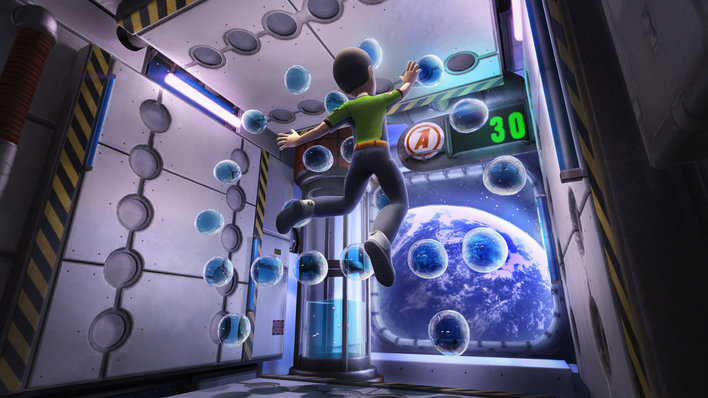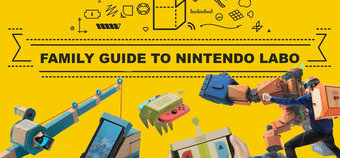As the game that comes bundled with every Kinect Sensor sold, Kinect Adventures is going to be most people's first experience with Kinect. Designed to highlight the strengths of the new sensor, Kinect Adventures is a collection of five minigames that'll have you moving around your living room, jumping, stretching, and otherwise contorting yourself into various positions that the human body really isn't meant to be in. The only problem is, as well as being a good showcase of the shiny new hardware, it also highlights a lot of Kinect's flaws - but we'll get to that later.
The first time you load up Kinect Adventures is something of a watershed moment, as you can't help but be impressed as to how accurate the tracking appears to be. Move your arm, your avatar moves theirs; do a little dance, and your avatar will follow suit (we did this quite a lot). It's a strange feeling to begin with, but one you'll quickly have to get used to, as Kinect Adventures requires you to move your whole body - constantly.
Once you've managed to set your Kinect sensor up, and, in our case, completely rearranged your living room (we don't think we'll ever enjoy doing this), you'll be good to go. If you want to play on your own, you'll need between 6-8ft of room - but if you want to play in multiplayer, you'll need 8 to 10ft. Don't think you can trick the game into thinking its got more room that it has, though, because before you can even start playing, you'll have to stand in a required zone for a second or two, to select your play space. If you're only bordering on having 8ft of room, and you can't stand 8ft back, you absolutely won't be able to play it in multiplayer - which is disappointing, to say the least.

Rallyball - not as responsive as it should be
The first minigame on offer, Rallyball, works a lot like a 3D version of Breakout, or Arkanoid (if you've ever played them!). With a number of blocks at the end of a corridor, it's up to you to smack a ball down said corridor, with the intention of destroying the blocks. When the ball hits a block (or the end of the corridor), it'll come back towards you, and you'll have to fail around like a loon as you try to hit it back. Hit a target, and more balls will get released, leading to an even wilder frenzy as you try to hit the balls back with every body part you've got. It's a great way to get yourself into the mindset of Kinect - using your whole body to interact with the game, but sadly, it's marred by both a delay in the input, which often leaves your avatar moving their arm a split second too late to hit the balls back, and the difficulty you have judging the distance between your avatar and the balls. Combined, they make what could have been a great intro to Kinect a slightly dodgy, if incredibly athletic and energetic experience.
Next up is River Rush, a game that sees you careering down some rapids in an inflatable dingy, and has been featured on most of Kinect's advertising, which, coincidentally, is where Kinect Adventures starts to get a lot better. Moving from side to side as you steer your raft left and right, jumping when you need to make the raft leap from the water, it may be kind of illogical, but this is easily the best game of the bunch, with the raft being nicely responsive to your movements as you crab from side to side to guide it through the course, collecting tokens as you go. It's not quite as tiring as the other games, but it still has great potential to wear you out after a few goes!

Exaggerated movements are the order of the day here - it's not as accurate as we'd hoped.
Reflex Ridge is the sort of thing you may expect to see on the Krypton Factor, or Takeshi's Castle. Putting your avatar on a platform that powers through an obstacle course, it's up to you to move left and right, or duck and jump to dodge the giant foam barriers that pop out to try and hit you. It's another game that takes a lot of getting used to, as seems to be a repeated trend with Kinect, as it's hard to tell exactly how much you've got to move from side to side to dodge the targets. It's a shame too, that although jumps over barriers are usually well picked up, when you jump to try and speed your little platform up (as it says you can do), Kinect seems rather hit and miss, occasionally giving you a speed boost, and occasionally not.
20,000 leaks is an interesting game which puts your avatar in a glass box underwater, which comes under attack from a number of cute, if seemingly homicidal fish. Purposefully ramming your tank, they'll keep knocking ever more holes in the wall, while you attempt to put your hand, head, foot, or other extremity over, which somehow magically repairs the glass. When you're being attacked from all angles, with holes appearing in the floor and walls, it gets a bit crazy, and you'll be dancing all over the place as you attempt to patch the leaks - but again, every now and then, this one suffers from the same flaw as Reflex Ridge, in that you're never sure how far you have to move. When leaks appear in the floor, you'll have to move either forwards or backwards to try and plug them with your feet, but it's hard to judge exactly how much you need to move. Move too much, again, and you may well run into problems with the sensor losing you. For the most part, though, it works, and is a solid, fun little game.
Last, and definitely least comes Space Pop, a weird game that sees you floating around in a zero G room, as you attempt to pop a number of bubbles that get released into the enclosure. Flapping your arms makes your avatar move towards the top of the screen, while there's seemingly little you can do to make them sink to the bottom again. It's all a bit awkward, and things just get more complex still, when then the game throws two layers of bubbles at you - one at the front of the room, and one at the back. Obviously, the perspective is of great importance here, but it's hard to tell where your avatar is in relation to the bubbles - and moving forward or backwards often ends in you stepping into or out of the play area, causing the sensor to lose you.

We just need to get a little perspective on things
While the little frustrations aren't too much of a problem on their own, and you can get over most of them as you learn to play the game, you are left wondering why something that's supposed to be so intuitive seems quite so awkward. More disappointing, however, is that Kinect Adventures, like Kinect itself, doesn't seem to have been designed to be played in multiplayer - which makes little sense, as that's exactly how minigames always work the best. If you add an extra player into the mix, things initially seem a lot more fun, and certain games, like Rallyball, become a lot easier with an extra player to take the strain. The only problem is, soon, things degenerate into a mixture of bruised arms, and "lost players", as you both swing for the same target, or one of you steps slightly out of the play area in an attempt to avoid the other. After you've finished each set of mini games, you'll be rewarded with a "moving statue", which is usually a scene involving your avatar, that moves as you do, and says what you say. The problem is, Kinect Adventures kept losing us at the end of every minigame set, replacing our avatar with that of a blond haired woman, which kind of strips them of their appeal. It can't be understated how daft that is, either. There are two people logged in. There are two people playing. Why does Kinect then suddenly decide it has no idea who I am, and presume I've turned into a woman with pigtails?
Frustrating though it may be, despite our misgivings, Kinect Adventures does have one thing that works strongly in its favour. As each of the games require you to use your entire body, even though you won't notice as you're playing, you'll be giving yourself a full body workout. Because it's a game - and not a fitness themed one, you actually don't really notice how hard you're working - it's only when the results screen comes up, and your legs start to buckle that you'll realise quite how much exercise you've been doing. As the nation, apparently, gets lazier by the day, Kinect Adventures' main strength is as a way to get you up and active.
While it can be frustrating at times, and, with its bugs, it isn't the best game to demo what Kinect's capable of, Kinect Adventures is, almost simultaneously exasperating, exhausting, and exhilarating. It's a great way to get you, and your kids up and active, as even though Kinect Adventures isn't marketed as a fitness game, you'll certainly work up a sweat by playing it - and that's just through rearranging your living room before you begin. Sadly, the few awkwardly designed minigames, and lack of thought that's gone into the multiplayer mode really brings the package down, but as a pack in game, we can't complain too much - although we'd probably have preferred having the £40 off the RRP.
Format Reviewed: Xbox 360





















